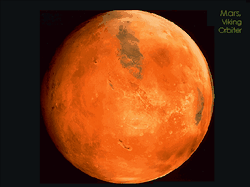Paper Reports Mars Could Have A Warmer, Wetter Climate In The
(Far) Future
 Favorable chemistry and episodes with thin films of liquid
water during ongoing, long-term climate cycles may sometimes make
the area where NASA's Phoenix Mars mission landed last year a
favorable environment for microbes.
Favorable chemistry and episodes with thin films of liquid
water during ongoing, long-term climate cycles may sometimes make
the area where NASA's Phoenix Mars mission landed last year a
favorable environment for microbes.
Interpretations of data that Phoenix returned during its five
months of operation on a Martian arctic plain fill four papers in
this week's edition of the journal Science, the first major
peer-reviewed reports on the mission's findings. Phoenix ended
communications in November 2008 as the approach of Martian winter
depleted energy from the lander's solar panels.
"Not only did we find water ice, as expected, but the soil
chemistry and minerals we observed lead us to believe this site had
a wetter and warmer climate in the recent past -- the last few
million years -- and could again in the future," said Phoenix
Principal Investigator Peter Smith of the University of Arizona,
Tucson.
 A paper about Phoenix water studies, for which Smith is the
lead author with 36 coauthors from six nations, cites clues
supporting an interpretation that the soil has had films of liquid
water in the recent past. The evidence for water and potential
nutrients "implies that this region could have previously met the
criteria for habitability" during portions of continuing climate
cycles, these authors conclude.
A paper about Phoenix water studies, for which Smith is the
lead author with 36 coauthors from six nations, cites clues
supporting an interpretation that the soil has had films of liquid
water in the recent past. The evidence for water and potential
nutrients "implies that this region could have previously met the
criteria for habitability" during portions of continuing climate
cycles, these authors conclude.
The mission's biggest surprise was finding a multi-talented
chemical named perchlorate in the Martian soil. This Phoenix
finding caps a growing emphasis on the planet's chemistry, said
Michael Hecht of NASA's Jet Propulsion Laboratory, Pasadena, CA,
who has 10 coauthors on a paper about Phoenix's soluble-chemistry
findings.
"The study of Mars is in transition from a follow-the-water
stage to a follow-the-chemistry stage," Hecht said. "With
perchlorate, for example, we see links to atmospheric humidity,
soil moisture, a possible energy source for microbes, even a
possible resource for humans."
Perchlorate, which strongly attracts water, makes up a few
tenths of a percent of the composition in all three soil samples
analyzed by Phoenix's wet chemistry laboratory. It could pull
humidity from the Martian air. At higher concentrations, it might
combine with water as a brine that stays liquid at Martian surface
temperatures. Some microbes on Earth use perchlorate as food. Human
explorers might find it useful as rocket fuel or for generating
oxygen.
Another surprise from Phoenix was finding ice clouds and
precipitation more Earth-like than anticipated. The lander's
Canadian laser instrument for studying the atmosphere detected snow
falling from clouds. In one of this week's reports, Jim Whiteway of
York University, Toronto, and 22 coauthors say that, further into
winter than Phoenix operated, this precipitation would result in a
seasonal buildup of water ice on and in the ground.

"Before Phoenix we did not know whether precipitation occurs on
Mars," Whiteway said. "We knew that the polar ice cap advances as
far south as the Phoenix site in winter, but we did not know how
the water vapor moved from the atmosphere to ice on the ground. Now
we know that it does snow, and that this is part of the
hydrological cycle on Mars."
Evidence that water ice in the area sometimes thaws enough to
moisten the soil comes from finding calcium carbonate in soil
heated in the lander's analytic ovens or mixed with acid in the wet
chemistry laboratory. The University of Arizona's William Boynton
and 13 coauthors report that the amount of calcium carbonate "is
most consistent with formation in the past by the interaction of
atmospheric carbon dioxide with liquid films of water on particle
surfaces."
The new reports leave unsettled whether soil samples scooped up
by Phoenix contained any carbon-based organic compounds. The
perchlorate could have broken down simple organic compounds during
heating of soil samples in the ovens, preventing clear
detection.
 Airborne-Flight Training 05.09.24: ERAU at AIAA, LIFT Diamond Buy, Epic A&P
Airborne-Flight Training 05.09.24: ERAU at AIAA, LIFT Diamond Buy, Epic A&P ANN's Daily Aero-Term (05.07.24): Hazardous Weather Information
ANN's Daily Aero-Term (05.07.24): Hazardous Weather Information Aero-News: Quote of the Day (05.07.24)
Aero-News: Quote of the Day (05.07.24) NTSB Final Report: Cessna 150
NTSB Final Report: Cessna 150 Aero-News: Quote of the Day (05.08.24)
Aero-News: Quote of the Day (05.08.24)





